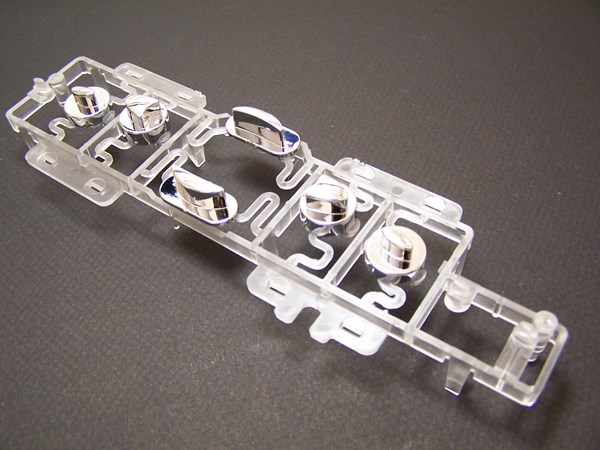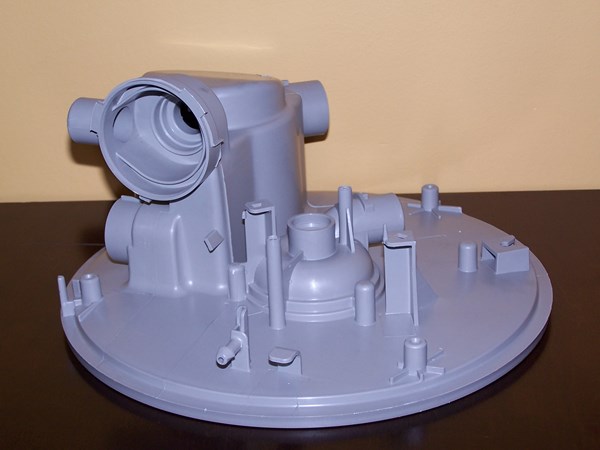Dispelling Aluminum Tooling Myths
Myths have always been around: the world is flat and the sun revolves around the earth— to name a few.
Myths have always been around: the world is flat and the sun revolves around the earth— to name a few. The world of manufacturing is no different with its own false beliefs. Today we have the myth that aluminum tooling is “junk tooling or for prototypes only”. This is a stereotype that has grown from earlier grades of aluminum—alloys that were gummy, difficult to cut and improperly used in a manufacturing environment. 
The development of aircraft grade 7075 aluminum brought forth a durable and quality product. In 1998 the SPE and Douglas Bryce wrote “Plastic Injection Molding: Mold Design and Construction Fundamentals” that discussed the quality of 7075 and the capacity to produce millions of parts. However, many manufacturers did not follow his recommendations. Instead, many chose the wrong aluminum alloy and did not follow good tooling practices. Unfortunately, the damage to aluminum’s reputation had already been done.
Cost factors are forcing manufacturers and major OEMs to take a second look at aluminum. Back in 1991 IBM did a five-year study on aluminum tooling with many credible findings. Currently, Honda’s ongoing aluminum tooling study is a success and other companies are taking a renewed interest in the cost savings that aluminum has to offer. Unfortunately, old beliefs are hard to overcome.
Myth #1: Aluminum tooling is just for prototypes and low volumes.
Aluminum can be used for production volumes: The mistaken belief that only steel alloys such as H-13, S-7, stainless steel or P20 steel should be used for production molds can be a costly one. An aluminum mold can provide volumes between 100,000 up to 1,000,000 components. This is due to current aluminum grades that are heat treated as part of their creation process resulting in a 6 - 18RC hardness. Surface coating treatments can harden aluminum up to 56 – 62RC depending upon the process. When these hardness levels are compared to P20’s 28 – 32RC and 420 stainless steel’s 34 – 38RC (pre-heat treated), this estimate of 1,000,000 seems conservative.
Myth #2: Limited resin types can be used in an aluminum mold prototype.
All resin types can be used on aluminum: Aluminum’s excellent thermal conductivity allows resins to flow more evenly than steel. Certain resins like clear acrylics and polycarbonates often have processing issues due to hot and cold spots in a mold. Aluminum’s even heat dispersion reduces these areas resolving bubble and other aesthetic issues. Other high-temperature resins can run successfully in aluminum with cartridge heaters that are normally used with steel molds. Difficult-to-fill resins with a high viscosity rate also benefit from even heating as it reduces sheer stress upon the material by balancing the flow of material with a hot runner system. Glass-filled and other abrasive resins can be run with success as long as special care is taken to either hard coat or steel insert critical areas. Glass-filled resins can actually run more efficiently with aluminum due to its consistent thermal conductivity that assists in the flow of resin. PVC is often incorrectly believed to be abrasive, when in fact it is corrosive. That is why stainless steel alloys are chosen over P20. Both stainless steel and aluminum are corrosion-resistant by nature. Aluminum forms a 0.000001 (microinch) self-healing layer as a reaction to oxygen called aluminum oxide. The chromium in stainless steel reacts the same way to oxygen forming a layer called chromium oxide. Some of the newer grades of aluminum have chromium added for even greater corrosion resistance. There are surface hardening processes that work well with PVC that can increase component output.
Myth #3: Aluminum cannot be used for production quantities.
The word “production” is subjective, as aluminum can achieve high volumes: How does “100,000 - 1,000,000 + production-quality plastic parts” sound? Not exactly short-run or low-volume. For many projects this is more than enough for the entire project until the next design change or upgrade. Of course higher production quantities can be achieved depending upon the resin and design. Aluminum tooling is also perfect for keeping marketplace share when bridge tooling is needed. An added benefit is that if the tool life is exceeded, aluminum is forgiving and easy to maintain or enhance in order to get those last few plastic parts until the hardened steel production tool is ready.
Myth #4: Aluminum tooling has limited textures and finishes versus steel alloy tooling.
Unlimited surface finishes: Almost any surface finish or texture that can be applied to a steel mold can be applied to an aluminum mold. This includes Class A diamond finishes (SPI A-1), which are required for chrome plating. Certain grades of aluminum are more suitable for this, which may also require a hard coating process to enhance this finish. Bead blasting or any aesthetic texture finish can also be achieved with success.
Myth #5: Aluminum tooling has process issues.
Faster process cycles: As mentioned above, the thermal conductivity is a benefit that eliminates many processing issues. Fast and even heating and cooling results in less shrink and warpage issues from uneven heat dispersion. Less scrap is a cost savings, but cycle times are also reduced by 30 percent on average, bringing down overall piece price. In order to run aluminum, a molder will need good tooling practices and maintenance routines to extend the tool life and fully realize all of the cost and time savings. This includes watching parting lines and shutoffs for wear to eliminate parts sticking and excessive wear. A sticking part can damage aluminum tools worse than steel. However, if the tool was built correctly and maintained to industry standards, it is not a common occurrence.
Myth #6: Can’t make tool modifications to soft tools like aluminum molds.
Design modification: Commonly, many projects in the planning and design verification stages go through some sort of design modification. Aluminum could not be easier to modify or groom for maximum efficiency when during the build or when the tool is running parts, modifications to the initial design or to troubleshoot production issues are necessary. Welding aluminum has become very successful recently, which allows consideration for even cosmetic changes as well.
Myth #7: Aluminum tooling cannot handle complex designs.
No design restraints: Complex design geometries that require under cuts, which require mechanical slides, lifters or hand loads can be done just like in a steel mold. Careful project planning, a strong knowledge of mold design, along with experience in machining aluminum means there is no reason to not expect aluminum to maintain critical dimensions. Steel inserts can be used to further maintain critical areas for higher volume projects. This can all be done in less time than traditional tooling because aluminum can be cut faster than other alloys.
Myth #8: Aluminum tooling is too expensive.
Lower overall cost: Cost is the 800 lb gorilla everyone wants to talk about. While aluminum costs more per pound than P20 and other steel alloys, aluminum is lighter in weight so the cost per pound usually is less in total cost. Aluminum is easier and faster to cut than steel; and, polishes faster, which reduces build time by weeks with substantial cost savings. Even hard coating aluminum does not add to the final cost of the tool significantly. Improved thermal conductivity cuts down process issues, with less scrap and faster cycle times, which reduces the overall per piece price. Then factor in less machine wear and less electrical costs due to improved efficiencies. Moreover, when the tool is no longer needed, aluminum is easily recycled.
Summary
In today’s economy and business climate every company that wants to stay lean and competitive in the marketplace needs to seriously consider the cost savings from aluminum tooling. Although there have been many improvements in the grades of aluminum alloys, proper design, tooling and molding practices need to be considered to truly reap the benefits of this alloy. In 35 years of aluminum tooling, the last five have been the most notable due to the attention that aluminum has finally been given. Like most successful innovations that are born from the need to survive, aluminum tooling is not just the bridge to a faster product launch or the cost savings necessary for the planned budget; it is a successful alternative to steel tooling with huge benefits that will continue to advance and influence the future of the plastics industry.
Contributor:
Robert Lammon is Director of Operations for Phoenix Proto Technologies.
For More Information:
Phoenix Proto Technologies
(269) 467-8300, ext. 300
bob.lammon@phoenixproto.com
phoenixproto.com
Related Content
The Benefits of Hand Scraping
Accuracy and flatness are two benefits of hand scraping that help improve machine loop stiffness, workpiece surface finish and component geometry.
Read MoreMoldmakers Deserve a Total Production Solution
Stability, spindle speed and software are essential consideration for your moldmaking machine tool.
Read MoreMachining Center Spindles: What You Need to Know
Why and how to research spindle technology before purchasing a machining center.
Read MoreSolving Mold Alignment Problems with the Right Alignment Lock
Correct alignment lock selection can reduce maintenance costs and molding downtime, as well as increase part quality over the mold’s entire life.
Read MoreRead Next
Are You a Moldmaker Considering 3D Printing? Consider the 3D Printing Workshop at NPE2024
Presentations will cover 3D printing for mold tooling, material innovation, product development, bridge production and full-scale, high-volume additive manufacturing.
Read MoreHow to Use Continuing Education to Remain Competitive in Moldmaking
Continued training helps moldmakers make tooling decisions and properly use the latest cutting tool to efficiently machine high-quality molds.
Read MoreHow to Use Strategic Planning Tools, Data to Manage the Human Side of Business
Q&A with Marion Wells, MMT EAB member and founder of Human Asset Management.
Read More


















